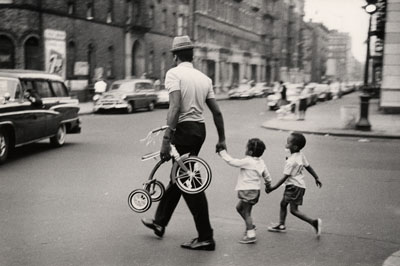The Magnum Print Room – Leonard Freed’s America
April 13 – May 28, 2011
63 Gee Street
London EC1V 3RS
United Kingdom
Leonard Freed, one of America’s greatest photojournalists. He was born in Brooklyn, in 1929 to working class Jewish immigrants from Belarus. He originally had ambitions to become an artist, however in 1954 he began to study photography at the New School under the esteemed Harpers Bazaar Art Director, Alexey Brodovitch. Exhibited at the print room, are both vintage and modern prints, are images drawn from two of Freed’s most significant American projects, Black in White America (1964-1965) and Police Work (1972-1979) as well as documents reflecting his lifetime interest in his Jewish heritage. Alongside these are photographs that record daily life in America, from Vietnam War protesters and Harlem fashion shows, to street life in Greenwich Village and weddings in Little Italy.
After studying Freed embarked on a two year journey, hitchhiking through Europe & North Africa, these resulting images were published in Freed’s first book Jews of Amsterdam (1959) & a solo exhibition in the Netherlands.Whilst on this journey his interest in civil rights developed, after he photographed a black American soldier at the Berlin Wall (shown below) and was shocked at the contrast between the man’s loyalty to the West and the struggle he perceived back home for basic civil rights.
In early 1960s he returned to America, Freed embarked on a project which was going to define his career; the documentation of Harlem and the Deep South, illustrating the inequalities between being black or white in 1960s America. The astonishing images, many in this exhibition, were published in Freed’s landmark book Black in White America (1967) and launched his photographic career. Freed would later to come to photograph civil rights figure Dr Martin Luther King, the 1963 March on Washington and the rallies performed by the Congress of Racial equality (shown below).
Follow the link to find out more.
Also included in this exhibition are celebrated images from Police Work, a project started by Freed in the early 1970s as a counterweight to what he saw as the police victimization by young middle-class antiwar protestors. Freed wanted to examine the police up-close and his intimate portrayal depicts neither stereotypical thugs nor saintly guardians, but harassed, badly-paid working class men simply trying to feed their families. Images such as a policewoman playing with local kids in Harlem, and a police officer relaxing in his pool with his family, demonstrate Freed’s ability to photograph subjects with humanity and compassion. A book of the work was published in 1980 and shown at The Photographer’s Gallery, London in 1973 under the title ‘The Spectre of Violence’ – a dramatic life-sized restaging involving entering the gallery through a black curtain and the discovery of a ‘corpse’ at the bottom of stairwell.
Leonard Freed produced significant essays on Poland, Asian immigration in England, North Sea oil development, and Spain after General Franco. He shot four films including The Negro In America (1968) and Joey Goes to Wigstock (1992) and his work was widely published in major magazines such as Life, Look, Fortune, Paris-Match and Sunday Times. Leonard Freed died in Garrison, New York, on 30 November 2006. A wider selection of Freed’s photographic career is currently touring, as the 230 piece exhibition Worldview curated by Bill Ewing, director of the Musée de l’Elysée, Lausanne, and published by Steidl (2007). Here below are a small amount of Freed’s spectacular work.











